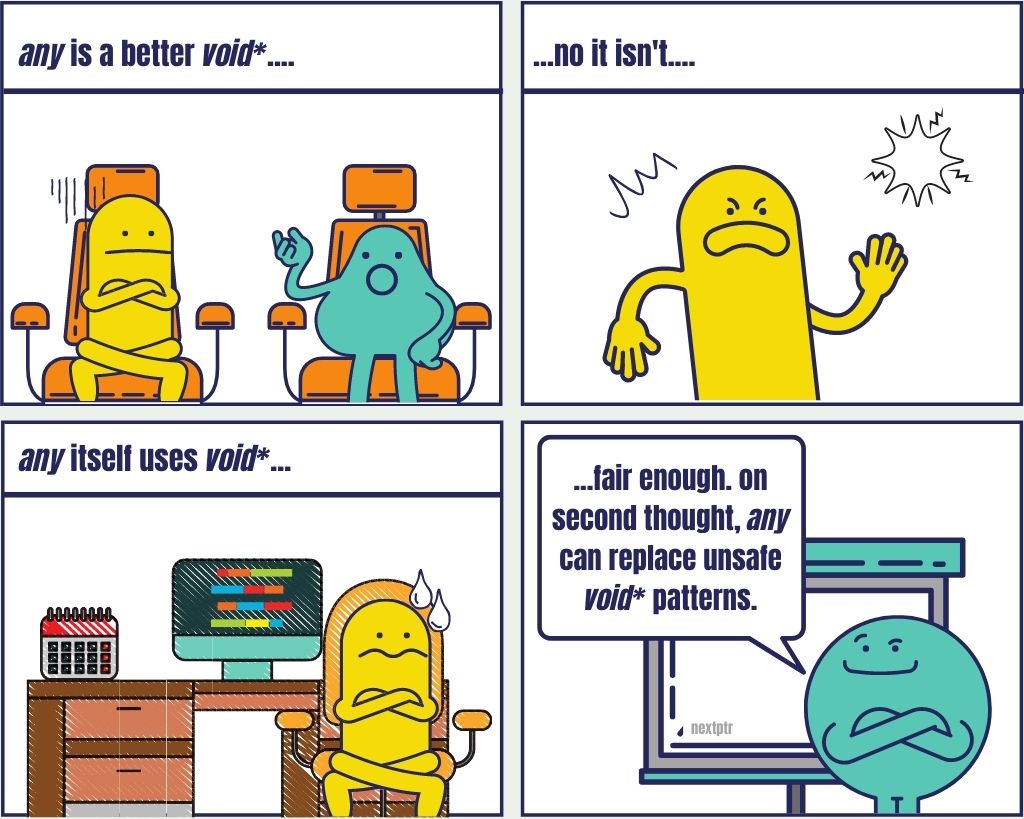On Design Patterns in C++--Jonathan Boccara'
Yo go iin more details.
On Design Patterns in C++
by Jonathan Boccara'
From the article:
Design patterns are a must-know in programming today...
March 23-28, London, UK
By Adrien Hamelin | Dec 18, 2020 01:52 PM | Tags: intermediate
Yo go iin more details.
On Design Patterns in C++
by Jonathan Boccara'
From the article:
Design patterns are a must-know in programming today...
By Adrien Hamelin | Dec 18, 2020 01:50 PM | Tags: c++20
 Interested?
Interested?
I'm Proud to Present my New Book: C++20
by Rainer Grimm
From the article:
I'm proud to present the early release of my book to C++20 on LeanPub. The book is 50 % done and has more than 300 pages and 150 code examples of content. I will update the book at least two times in 2021. Of course, you will get each update of the book
By Hitesh Kumar | Dec 15, 2020 11:03 AM | Tags: c++17
An introduction to std::any and comparison with void*.

std::any - comparison with void* and motivating examples
by Hitesh Kumar
From the article:
std::any is often compared with void* because the latter has been the de-facto choice for storing or passing the arbitrary objects in C++ since the outset. std::any is not a replacement of void*, but it is a safer substitute for the boilerplate patterns built around void*. Nevertheless, a comparison between the two is required for a better understanding of std::any.
By Adrien Hamelin | Dec 14, 2020 02:04 PM | Tags: c++20
Control when you need atomicity.
Atomic References with C++20
by Rainer Grimm
From the article:
Atomics receives a few important extensions in C++20. Today, I start with the new data type std::atomic_ref...
By Adrien Hamelin | Dec 14, 2020 01:57 PM | Tags: c++17
You like the style?
C++17 structured bindings for more safe, functional code
by Dmitrii Khizbullin
From the article:
The overall idea of this article is to showcase how to keep the scope (aka block) as clean as possible with C++17. By “clean” scope I mean two things:
- as few variables as possible,
- all variables are const as often as possible...
By Adrien Hamelin | Dec 8, 2020 01:25 PM | Tags: c++20
Some bits and stuff.
Bit Manipulation with C++20
By Rainer Grimm
From the article:
This post concludes my presentation of library features in C++20. Today I write about the class std::source_location and a few functions for bit manipulation...
By Adrien Hamelin | Dec 8, 2020 01:20 PM | Tags: c++20
Use all that you can.
Feature Testing with C++20
by Rainer Grimm
From the article:
When your program's compilation broke with a brand-new C++20 feature, you often end with a few questions: Did I something wrong? Did I found a compiler bug? Does my compiler not yet support this feature? Thanks to the feature testing in C++20, the last question is easy to answer...
By Adrien Hamelin | Nov 30, 2020 01:05 PM | Tags: advanced
Lambdas.
Under the Covers of C++ Lambdas: Captures, Captures, Captures
by Andreas Fertig
From the article:
Lambda Capturing syntax allows us to quickly “wrap” a variable from the outside scope and then use it in the lambda body. We also know that under the hood the compiler translates lambda into a closure type… but what happens to those captured variables? Are they translated to public data members or private? See the newest guest post from Andreas to understand this tricky problem...
By Adrien Hamelin | Nov 30, 2020 01:00 PM | Tags: c++20
Will you use it?
Safe Comparisons of Integrals with C++20
by Rainer Grimm
From the article:
When you compare signed and unsigned integers, you may not get the result you expect. Thanks to the six std::cmp_* functions, there is a cure in C++20...
By Hitesh Kumar | Nov 30, 2020 11:22 AM | Tags: None
The current object (*this) capture in a lambda expression has gone through some changes since C++11.
Capture *this in lambda expression: Timeline of change
by Hitesh Kumar
From the article:
A lambda defined inside a non-static member function can directly access the members of the current object (or its copy) via an appropriate capture clause. But how the current object can be captured has gone through some changes since C++11.